- Visibility 1.2k Views
- Downloads 25 Downloads
- DOI 10.18231/j.agems.2024.002
-
CrossMark
- Citation
Millets: A review of its properties as per Ayurveda
- Author Details:
-
Nileema Shisode *
Introduction
Millets are largely cultivated in India. 80% of millet production among Asia is by India. India contributes 20% of world’s millet production. Millets needs very less water, can grow in high temperature, and requires minimal care. Year 2018, was celebrated by India as a millet year. To increase its awareness India suggested UNO, to declare millet year, 72 countries supported this idea, because of which year 2023, is declared as ‘International millet year’ by UNO. Global warming, micronutrients deficiency, decreased water level, increased percentage of ‘santarpanjanya diseases’- diseases of over eating, such as obesity, diabetes, are the key factors suggesting importance of millets. India is rank one in production of millets. Every year India harvests 170 lakh matric tone millets.
Ayurveda describes food in 12 categories, Out of which millets are described under category ‘shukdhanyavarg’. It is necessary to understand Ayurveda aspect about millets. This article will help to understand what Ayurveda explains about millets. Some millet is described as wholesome diet, but most of them are especially recommended to treat diseases of kapha, and meda vitiation.
Materials and Methods
Ayurveda original texts, web articles, Ayurveda articles are the main source of information.
|
Sr.no. |
Name of millet |
Charak |
Sushrut |
Vagbhat |
Bhavprakash |
|
1 |
Kordush /kodrav |
+ |
+ |
+ |
+ |
|
2 |
Shyamak ( barnyard millet), |
+ |
+ |
+ |
+ |
|
3 |
hastishyamak (big barn yard millet), |
+ |
- |
+ |
+ |
|
4 |
ambh shyamak( barn yard millet grown in water |
+ |
- |
- |
- |
|
5 |
Nivar ( rice grown without cultivation) |
+ |
+ |
+ |
- |
|
6 |
Toyaparni |
+ |
- |
- |
- |
|
7 |
Gavedhuk (small wheat), |
+ |
+ |
+ |
+ |
|
8 |
Prashatika ( redbeak) |
+ |
- |
+ |
- |
|
9 |
Lohitanu ( red small grains) |
+ |
- |
+ |
- |
|
10 |
Priyangu ( fox tail millet |
+ |
+ |
+ |
+ |
|
11 |
Mukund (vkastrun) |
+ |
+ |
- |
+ |
|
12 |
Zinti |
+ |
- |
- |
- |
|
13 |
Garmuti |
+ |
- |
- |
- |
|
14 |
Varuk ( charuk-shanbeej/sharbeej), |
+ |
+ |
- |
+ |
|
15 |
Varak (shyambeej-black grains, Chinak |
+ |
+ |
+ |
+ |
|
16 |
Shibir (siddhak-) |
+ |
- |
- |
- |
|
17 |
Utkat |
+ |
- |
- |
- |
|
18 |
Jurn |
+ |
- |
- |
+ |
|
19 |
Shantanu |
- |
+ |
- |
- |
|
20 |
Uddalak |
+ |
+ |
+ |
- |
|
21 |
Madhulika |
- |
+ |
+ |
- |
|
22 |
Nandimukhi |
- |
+ |
- |
- |
|
23 |
Kuruvind |
+ |
+ |
+ |
- |
|
24 |
Sar |
- |
+ |
- |
- |
|
25 |
Todaparni |
- |
+ |
- |
- |
|
26 |
Venuyav - bamboo rice |
- |
+ |
+ |
+ |
|
27 |
Gadi |
- |
- |
+ |
- |
|
28 |
Varunpadika |
- |
- |
+ |
- |
|
29 |
Shilbika /shibir |
- |
- |
+ |
- |
|
30 |
Shishir |
- |
- |
+ |
- |
|
31 |
Antnirgandi |
- |
- |
+ |
- |
|
32 |
Venuparni |
- |
- |
+ |
- |
|
33 |
Yava |
+ |
+ |
+ |
+ |
|
34 |
Kusumbbeej |
- |
- |
- |
+ |
|
Sr. no |
Millet |
Rasa |
Virya |
Vipak |
guna |
Action on dosha |
dhatu |
mala |
disease |
|
1 |
Kordush / kodo millet |
Astringent,sweet |
Cold touch |
Katu/pungent |
Dry, light |
Kapha Pitta balencing, vata increasing |
lekhan |
Absorb kleda Baddhavinmutra, shoshan |
More sangrahi, anti-poisonous |
|
2 |
Shyamak / sama millet |
Astringent,sweet |
Cold |
Katu |
light |
Vata increasing, kaphapitta balencing |
lekhan |
Constipating, shoshan |
Raktapitta/ bleedingdisorders |
|
3 |
Hastishyamak / wild sama millet |
Astringent,sweet |
Cold |
Katu |
light |
Vata increasing kaphapittaghna |
lekhan |
Constipating, shoshan |
Diabetes, obesity |
|
4 |
Nivar / rice grown without cultivation |
Astringent,sweet |
cold |
Katu |
light |
Pittaghna, kaphavatakrut |
lekhan |
Constipating, shoshan |
|
|
5 |
Priyangu Foxtail millet |
Astringent,sweet |
Cold |
Katu |
Dry, heavy |
Kapha balencing |
Bruhan Aphrodisiac, raktapitta |
Sangrahi, shoshan |
Bhagnasandhankrut, raktapitta, obesity, antipoisonous |
|
6 |
Varak /chinak/ proso millet |
sweet |
Hot |
Sour |
Heavy |
Tridoshakar |
|
Excess urination &defecation |
|
|
7 |
Uddalak /wild kodo |
sweet |
Hot |
Sour |
heavy |
Tridoshakar |
Prameh cause |
Bahumutra,purish |
Not good for consumption |
|
8 |
Vanshayava / bamboo rice |
Sweet, Astringent. |
Hot |
katu |
Dry |
Kaphahara vata pitta vitiatting |
medaghna |
Baddhamutra, sara |
Krumihar, vishaghn, balya |
|
9 |
Gavedhuk / Job’s tear |
Pungent, tasty |
Cold |
Sweet |
light |
kaphaghn |
medaghna |
Mutrajanan, shoshan |
Karshyakrut, |
|
10 |
Jurn-sorghum |
Astringent,sweet |
Cold |
Sweet |
Light, dry |
kaphapittaghna |
Avrushya, blood purification |
Sangrahi, shoshan |
Kledakrut, good inrakta vikar |
|
11 |
Yava /barley |
Sweet, Astringent |
Cold |
katu |
Dry, aguru/heavy, mrudu, picchil |
Excess vata producing, kaphapittaghn |
Medha,agnivardhan, medaghna, vrushya |
Excess feces producig, laxative-sar, control urine production |
Sthairyakrut, balya, vranropan,lekhan, anabhishyandi, swarya, kanth,twak, peenas,shwas,kasa, urustambha,blood diseases |
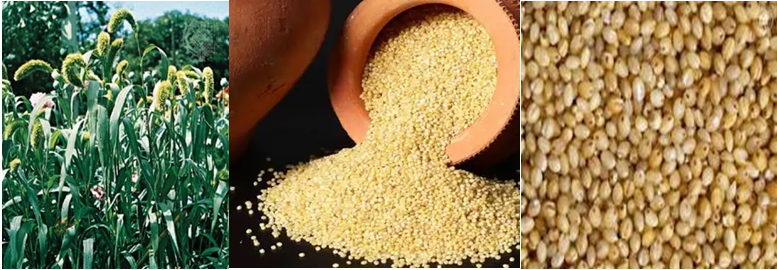
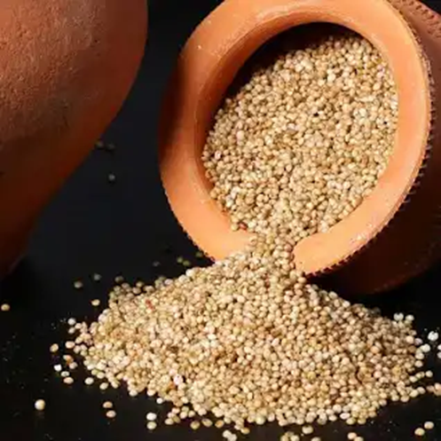
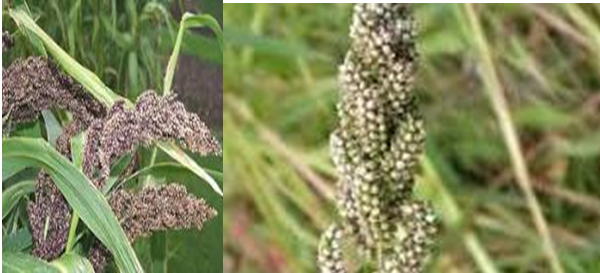
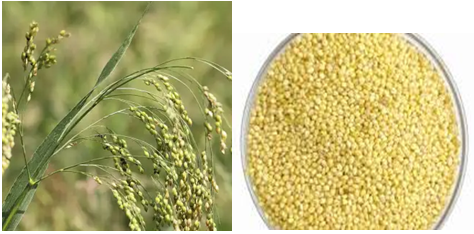
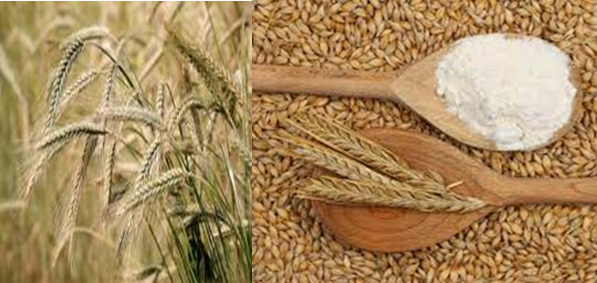
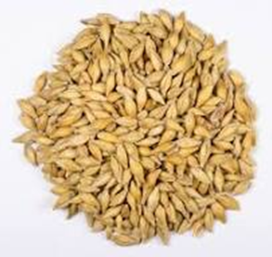
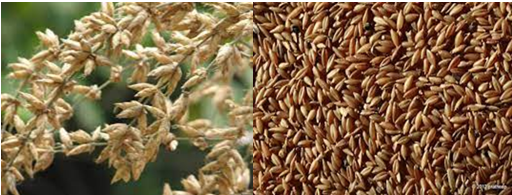
Millets as in Ayurveda
Monocoat grains are of two types. Some grains are big in size for e.g. wheat, rice, barley; and monocoats of small size are called as millets, for e.g. sorghum, pearl barley, amaranth, foxtail millet, shyamak etc. We found description of millets as trundhanya, kudhanya, kshudradhanya, tucchadhanya, in Ayurvda. All these millets are produced from grass like plants. In Sanskrit ‘trun’ is synonym for grass, and ‘dhanya’ means grains. The grains which are produced from grass like plant is called as ‘trundhanya’. Millets contains lots of fibers and contains least nutrition, less calorie value, taste is also compromised as compared to regular grains, hence it is named as ‘kudhanya’, or ‘kshudradhanya’. Ku’ means bad, or with less value. ‘Ku’ has another meaning as its plant-the grass is used to prepare mats, for that dry grass is used which is called as ‘kusa’, hence the name is ‘kudhanya’. These millets can be grown in scanty water, also in high temperature, requires less care, hence they are considered as of less value. ‘Kshudra’ means small, or minor, or not important. As compared to rice, wheat these grains are not really staple food, hence considered as less important to nourish human being; most of the time they are used as food of pet animals.’tuccha’ means-not important, hence called as ‘tucchadhanya’ by Hemadri, the commentator of Vagbhat. ‘Tucchadhanya’ has one meaning as ‘chaff’ means fibers. The grain which contains lots of fibers, less useful to increase weight, hence considered as ‘tucchadanya’. There are 13 types of millets available globally,which include pearl millet, finger millet, sorghum, little millet, proso millet, kodo millet, barnyard millet, brown top millet, foxtail millet, Guinea millet, Job's tears, fonio, and teff. Except for Job's tears, fonio, and teff, the other millets are widely distributed in India. Finger millet is widely found in India, China and in some Eastern and Southern African countries, whereas fonio is widely distributed in Western Africa and Job's tears in northeast India, southern and eastern Asia and southern China. On the other hand, teff is mainly found in Ethiopia. Currently, these crops are mostly grown in Africa and Asia as well as in the USA, which is the largest producer of sorghum. Millets also occur in other parts of the world as feed and fodder or as a minor crop.
Varieties of millets
Ayurveda describes many varieties of millets. Kordush, shyamak( barnyard millet), hastishyamak (big barn yard millet), nivar ( rice grown without cultivation), toyaparni, gavedhuk (small wheat), prashatika( redbeak), ambh shyamak( barn yard millet grown in water), lohitanu (red small grains), priyangu( fox tail millet), mukund (vkastrun), zinti, garmuti, varuk( charuk-shanbeej), varak (shyambeej-black grains), shibir (siddhak-), utkat, jurn( jondhale- jwari- sorghum), these millets are described by Charak.[1] Sushruta describes, shantanu, uddalak, madhulika, nandimukhi, kuruvind,sar, todaparni and venuyav- bamboo rice as additional varieties of millets.[2] Ashtang sangraha describes some extra milles named as, gadi, varunpadika, shilbika, shishir, antnirgandi, and venuparni.[3]
Common properties of kudhanya- Accoding to Sushruta, all grains of kudhanya are hot in potency, astringent, sweet, dry, after effect is pungent, kapha pacifying, reduces urine, vata, pitta increasing, except few grains. Vagbhata describes its properties as cold, kaphapitta balancing and lekhna- helps to lose weight. Bhavprakash narrates its potency as semi-hot-anushn. It’s after digestion effect is pungent, as per bhavprakasha. It is very good to absorb bad water content from body. Kodrav, nivar, shyamak, shantanu these grains are sweet, astringent, cold, and pitta pacifying1. Kaiydev nighantu describes it as bad for shukra and rakta-blood.
In spite of all these properties, while describing wholesome diet Sushrut enlist some millets, nivar, kodrav, uddalak, shyamak, and venuyava. Dalhane explains that as these grains are not increasing vata in large quantity, and not bad for our nutrition, it is wholesome diet.
While describing about good nourishment, charaka explains that, food which nourishes body and mind, satisfies our sense organs with its good appearance, smell, and color and also ignites digestive fire is wholesome food. Heavy diet leads to suppress digestive fire hence we can’t always recommend heavy diet as a regular diet. That is why millets are included in wholesome diet by Sushrut.
Millets are recommended,
When digestive fire is diminished.
Obstructive pathology
Kaphapitta vitiation
Diseases aroused from heavy, oily food consumption.
Diseases of accumulation of bad water content e.g. diabetes, obesity.
Anabolic diseases such as diabetes, itching, urticaria, anaemia, fever, all skin diseases, indigestion, urinary disorders, impotency, giddiness, anorexia, obesity, laziness, heaviness, obstructive pathology in ch[4]nnels, sense organs, unconsciousness, excessive worries, and edema.
Millets listed in shasti shali
Millets listed in shashtic shali-rice which requires 60 days for cultivaton are of good quality, they are ripen inside corn, cultivated in summer-grishm season. kangu (fox tail millet), is listed in this. It is grown in summer, hence considered as wholesome diet for regular use. Crop cultivated in rainy season and harvested in sixty days are of less quality, than crops cultivated in summer season. Varak, uddalak, china,sharad, ujjwal, dardur, gandhan, kuruvind, are its name. Hayanak, yavak, chinak,uddalak, naishadh, itkat are also shsati rice grown in rainy season hence considered to increase kapha and meda in body.
Millets description
Priyangu- kangu-it is a panic seed, Panicum Italicum; foxtail millet; family-Gramineae Meaning of kangu is, to become black or turn dark and also to lose original color, luster, and reputation. It grows where water is available radially. It satisfies who eats it, it is very nutritious hence the name kang. It is tasty and healthy millet good for weight gain-bruhan. It is 3rd rank most cultivated millets in world. It is grown in Europe, USA, Australia, North Africa and China.
Priyangu is of four varieties, black, red, yellow and white. Gradually they are superior in quality, more dry, and kapha pacifying gradually. It has capacity to rejoin broken bones. It is dry by nature and heavy for digestion. It is kapha pacifying and strength giving, hence considered as wholesome diet for everyday use. It is cultivated only in 10 days; and can be harvested within 80 days. Priyangu is sweet, astringent by taste, it’s after digestion effect is sweet. Its potency is cold. It is good for shukra as it is aphrodisiac. [2], [1], [5], [6]
Therapeutic uses of foxtail millet
Joins broken bones- astringent property of priyangu is useful to rejoin broken bones. This property is mentioned by all authors.
Wound healing: Add root of priyangu in rice prepared from kangu mixed with curd prepared from buffalo milk and consume it for non-healing wound. Astringent, dry, properties of priyangu helps to absorbs bad water content-kled in wounds and promotes wound healing.
Obesity- dry, kapha and fat reducing-lekhan property of kangu helps to reduce weight. Priyangu helps to clear channels.
Diseases for vitiated breast milk- breast milk are byproduct updhatu of rasa dhatu-tissue. Rasa always get contaminated because of overeating; light, dry, vata promoting kapha pacifying properties of foxtail millet helps to reduce undigested food part-aama from breast milk-stanya and cures diseases of stanya (breast milk) vitiation.
Raktapitta-bleeding disorders- shyamak and kangu millets are recommended in this condition.
Duodenal ulcers- aanadravakhya shul- vangsen recommends sweet payasam prepared from priyangu and milk, ghee, sugar for this condition. It helps to digest sama pitta- undigested vitiated pitta dosha; its astringent, cold, bruhan property helps in this. Priyangu is also recommended in hyperacidity-amlapitta patients.
Anti-poisonous- charak explains to eat kangu and kodo millet in poisoned patients.
Kaṅgu is also mentioned as being mutually incompatible (viruddhāhāra) with Paya (milk). Kaṅgu is also mentioned in a list of potential causes for indigestion. A complete section in ‘Bhojanakutūhala’ is devoted for the description of agents that cause indigestion. These ingredients when consumed in large scale can cause indigestion to certain people. The remedies for these types of indigestions are also explained, for example mantha.
Chinak-vari- proso millet, Indian millet, Pannicum miliaceum Linn is its botanical name. kak-kangu, shlashnak,sushlashn, these are other Sanskrit names. Its properties are like foxtail millet; it is explained as variety of kangu by our scientists, as ’kakkangu’. It is included in ‘shashtic Sali’. It is sweet, after digestion effect is sour, pitta increasing, heavy for digestion, produces more urine and feces, hot in potency, and tridosha vitiating grain. [5], [3] Being a short duration crop (60 -90 days) with relatively low water requirement, this escapes drought period and, therefore, offers better prospects for intensive cultivation in dry land areas. Under un- irrigated conditions, proso millet is generally grown during kharif season but in areas where irrigation facilities are available; this is profitably grown as summer catch crop in high intensity rotations.
Kordush-kodo millet, Paspalum scrobiculatum; kodrava, kordush, are its synonyms. It is cold, vata increasing pitta kapha pacifying, and constipating by nature. It has anti-poisonous property. With its outer covering, this crop can sustain up to 50 years. It is astringent and sweet by taste, and light for digestion. It is astringent, sweet, light for digestion, vata increasing, kaphapitta pacifying by properties. These are cold by potency, constipating, helps to reduce bad water content in body. [2], [1]
Uddalak-vankodrav:wild kodo- kodo millet which is grown without cultivation. It is hot, [6] constipating and vata increasing. It is gown in rainy season-varsha season, cut in kartik season. Sometimes naturally this crop develops intoxication, which may be harmful for human consumption.it is constipating, pitta kapha balancing, and profuse vata producing grain.
Shyamak-sama- Japanese barnyard millet: Echinocholoa frumentacea link: Sama,shyamak, shyamak, shyam, tribeej, avipriya, sukumar, rajdhanya, trunbeejottam, these are synonyms of Shyamak. It is astringent, sweet, light for digestion. It has capacity to absorb bad water content, dry by nature, vata increasing, and kaphapitta pacifying. It is cultivated in 6 wks.
For absorption of kleda-bad water content in body, shyamak is given with kusha and aamla.
Hasti shyamak-big sama, nivar-rice growing without cultivation, toyparni, gavedhuk-small wheat, prashatika, ambshyamak-sava grown in water, lohitanu, priyangu, mukund, zinty, gurmuti, varuk, varak, shibir, utkat, jurn- big millet-sorgham, all have properties like shyamak [1] barnyard millet, is astringent, sweet, light for digestion, vata increasing, kaphapitta pacifying by properties. These are cold by potency, constipating, helps to reduce bad water content in body. [1]. It is wholesome diet to eat in madhumeha and sthaulya-obesity. [7]
Yava-barley- different varieties are mentioned by ‘Bhavprakash’. Yava is with white barn, when its outer covering barn is removed it is called as ‘tokya,’when it is without cover but color is blackish it is called as ‘atiyava’, when it is small, green, it is called as ‘jai’.
Astringent, sweet, dry, cold, light for digestion, gas producing, feces producing, stabilizes body, strength giving, kapha pacifying are its properties. [1] Yava are sweet, astringent, cold, after effect is pungent, kapha, patta balancing, good in patients of wound. It is ‘anbhishyandi’-It reduces bad water content in body, decreases quantity of urine, increases vata and fecal matter. It increases stability of body, increases appetite, voice quality, complexion, intelligence. It is sticky, yet reduces weight and heaviness in body, and also reduces fat, and thirst. It is very dry by property, hence cleans body channels-‘strotas vishodhan’; it nourishes good pitta and blood. [2]
Therapeutic uses of yava
It is a wholesome diet to eat in madhumeha and obesity. [7] it is heavy for digestion.[6] It is good for weight loss; it is dry, gives satiety, heavy for digestion, constipating and we can prepare many varieties of food dishes from it, hence very good grain for weight loss and diabetes patient.
It is good in diseases of throat, voice-swarya [6]
Skin diseases, and also diseases produced because of increased kapha, pitta, and fat.
It is also good in sneezing, asthma, cough, chest diseases,
Good for excessive thirst
Blood diseases.
Wound healing [6]
Ignites digestive fire [6]
Good for intelligence [6]
Strength giving, stabilizing-sthairya
Complexion enhancing-varnya
Atiyava-it do not have outer covering-‘shuk’, its colour is black, red. It is inferior to yava in quality2 Yavak- small java-small barley-causes more urine production.
Vanshayava: bamboo rice: Bambusa arundinacea wild: this is dry, astringent by taste, after effect is pungent. It is kapha pacifying and vata pitta increasing, hot and laxative by nature. It is good in frequency of micturition- baddhamutra.
Yavnal/jurn: Panera: sorghum:jwari: Sorghum vulgare pers, family-Gramineae. It is tasty, aphrodisiac, astringent, cold and dry by nature. It is good for blood purification, balances kapha and pitta. It is light for digestion. It is mutrajanan, helps in urine production. It produces bad water content kled in body as it contains 13% moisture in it. [6]
Gavedhuk: Coix lacryma jobi Linn is its botanical name family-Gramineae. It is called as adlay millet or Job’s tear in English, kasai in marathi. It is pungent, sweet and weight reducing grain. It is vata and agni prominent grain, reduces kapha and meda. [6]
Roasted gavedhuk cooked to prepare porridge with honey helps to reduce weight.
Hyperacidity with vomitting- root of gavedhuk soaked in cold water- heem- helps to reduce bouts of vomiting.
Urinary incontinence- mutrakrucchrahar- helps to break urinary stone and thus helps dysuria. It helps to expel out urine-mutrajanan.
Madhuli and nandumukhi are is sweet, cold, and unctuous.
Charuk: Saccharum munja Roxb, family: Germineae –sharbeej-it grows on river bank. It is sweet, dry, vata increasing, blood, kapha, pitta pacifying, cold by nature, light for digestion; good for shukra nourishment, aphrodisiac, sweet, astringent by taste. It is good to satisfy thirst. It is more urine producing.[6] It is used in burning, thirst, blood impurities, dysuria, diseases of eyes, and tridosha balancing grain. [6]
Kusumbh beej: varata, varatica, vanhishikha, vastraranjak, safflower, parrot seed, bastard saffron are its name. Carthamus tinctorius Linn; is its botanical name family-Compositae. It is sweet, astringent, unctuous, cold, and heavy for digestion, aphrodisiac, good for all three dosha and rakta-blood impuriries.[6] Oil from safflower is laxative and good to consume in type 2 diabetes mellitus. For external use, it is used as anti-inflammatory, analgesic, to reduce itching, and helps in wound healing. Kusumbhabeej oil is used in renal calculi and dysuria.
Nivar: prasadika, trunanna, tini, devbhat are its synonyms. It is cold in potency, constipating, kaphavata increasing and pitta stabilizing grain. It is light for digestion. Its botanical name is Hygroryza aristata ness, family- gramineae.it is water prominent herb found in Asam. [6]
Mukundak and varuk are good to absorb bad water content kleda in body.
For prameha, millets such as nivar, fox tail millet, java-barley, bamboo rice, kodo millet, barnyard millet, kurubind and mukundak these small grains, are wholesome diet for prameh8. Charuk(sharbeej). Kusumbh beej (safflower), gavedhuk, nivar, these are not recommended for diabetes. Hayanak, yavak, chinak, uddalak, naishadh, itkat, all these small millets can cause diabetes after regular consumption. Yavak, hayan, pansu,bashp, naishadh thse grainsare ot,sweet, heavy, unctuous, laxative, urine producing, kaphapitta increasing grains. It’s after digestion effect is sour, hence not recommended for regular consumption.
Discussion
As we observe, millets are most probably sweet, astringent, cold, dry, light for digestion. They are good for therapeutic use, to reduce kapha and meda from body. It reduces kleda bad water content in body. They are useful to reduce weight, to manage diabetes type 2 patients, also in patients with less appetite. They have good nutrition in them, but they are not recommended for regular use. They are nutritious but less than the regular grains like rice and wheat. They are named as kudhanya or kshudra dhanya for its less nutrition value. Chinak and uddalak are not recommended for humans as they are thridosha vitiating grains.
list of small grains listed by our authors
list of rasa,virya, vipak,prabhav, action on dosha, dhatu, mala and diseases of millets.
Conclusion
Most of the millets are hot in potency, astringent, sweet, dry, after effect is pungent, kapha pacifying, reduces urine, vata, pitta increasing, except few grains. Priyangu, nivar, yava, yavanal these are more nutritious grains for consumption of every individual. Shyamak, kodo, korush, atiyav, vanshyava, gavedhuk, these grains are kaphameda reducing, hence used in all anabolic diseases-santarpanjanya vikar. Some grains having lots of bad water content in it-kleda are advised not to eat for diabetes patients, listed as Hayanak, yavak, chinak, uddalak, naishadh, itkat Yavak, hayan, pansu,bashp, naishadh etc. Millets like shyamak, kodrav, kangu, yava, venuyava, gavedhu are recommended, when digestive fire is diminished, diseases of obstructive pathology, Kaphapitta vitiation, diseases aroused from heavy, oily food consumption, diseases of accumulation of bad water content and anabolic diseases such as diabetes, itching, urticaria, anaemia, fever, all skin diseases, indigestion, urinary disorders, impotency, giddiness, anorexia, obesity, laziness, heaviness, obstructive pathology in channels, sense organs, unconsciousness, excessive worries, and edema.
Good clinical study is necessary to confirm these properties explained in text.
Author Contribution
Collection of data, and its analysis is done by dr. nileema shisode.
Source of Funding
None.
Conflict of Interest
None.
References
- SBG Ghanekar. . Charak samhita 1999. [Google Scholar]
- S Samhita, BG Ghanekar. . Charak samhita 1999. [Google Scholar]
- . Ashtang hruday-sutrasthan adhyay 6, annaswaroop vidnyaniya adhyay. Chaukhamba Sanskrit series 2006. [Google Scholar]
- C drudhbala, A Dipika, S Vyakhya. . Charak samhita 1992. [Google Scholar]
- PJ Sharm Vajpeyi. . Chakradatta 1998. [Google Scholar]
- B Mishra. . Bhavprakash . [Google Scholar]
- Chakrapani. . Chakradatta 1959. [Google Scholar]
- Introduction
- Materials and Methods
- Millets as in Ayurveda
- Varieties of millets
- Millets listed in shasti shali
- Millets description
- Therapeutic uses of foxtail millet
- Therapeutic uses of yava
- Mukundak and varuk are good to absorb bad water content kleda in body.
- Discussion
- Conclusion
- Author Contribution
- Source of Funding
- Conflict of Interest
